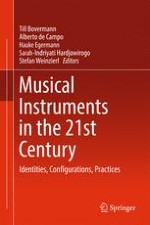2017 | OriginalPaper | Chapter
Mapping, Causality and the Perception of Instrumentality: Theoretical and Empirical Approaches to the Audience’s Experience of Digital Musical Instruments
Authors : Gina Emerson, Hauke Egermann
Published in: Musical Instruments in the 21st Century
Publisher: Springer Singapore
Activate our intelligent search to find suitable subject content or patents.
Select sections of text to find matching patents with Artificial Intelligence. powered by
Select sections of text to find additional relevant content using AI-assisted search. powered by
